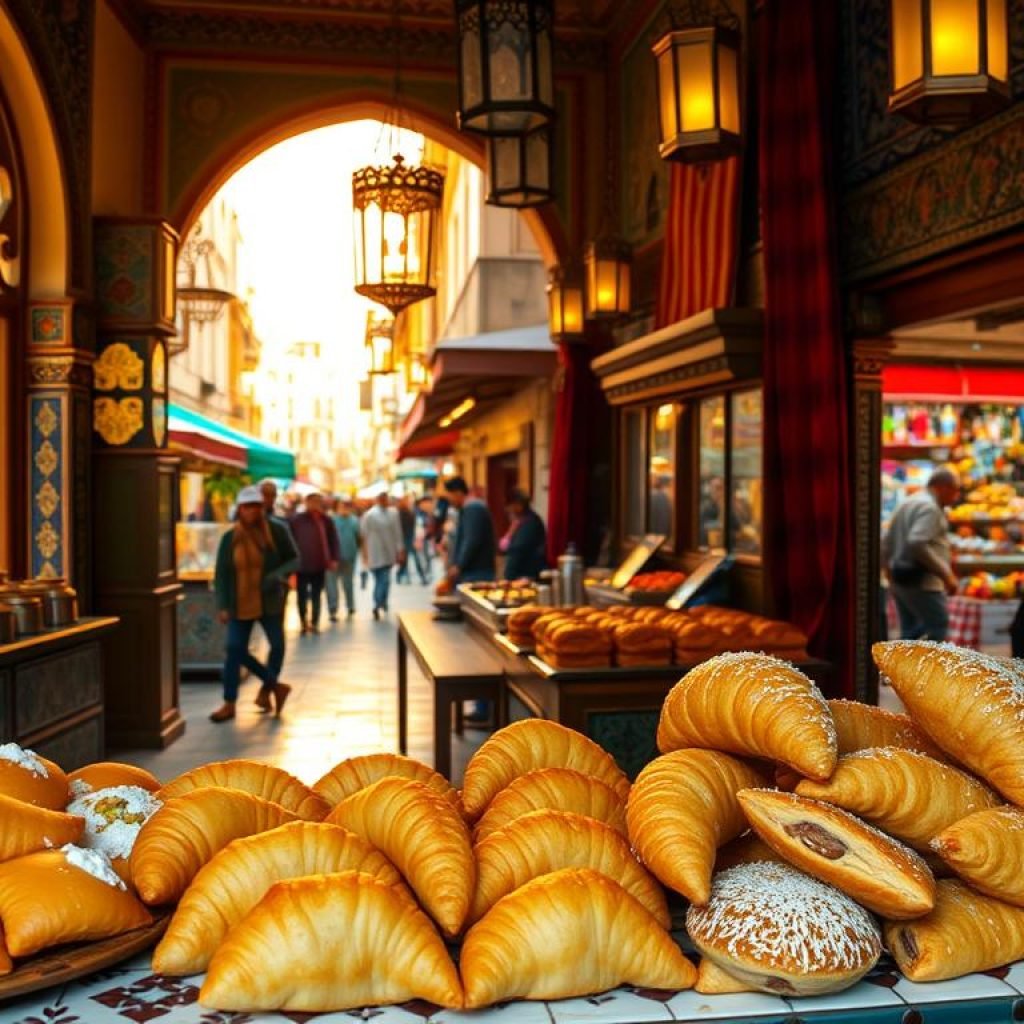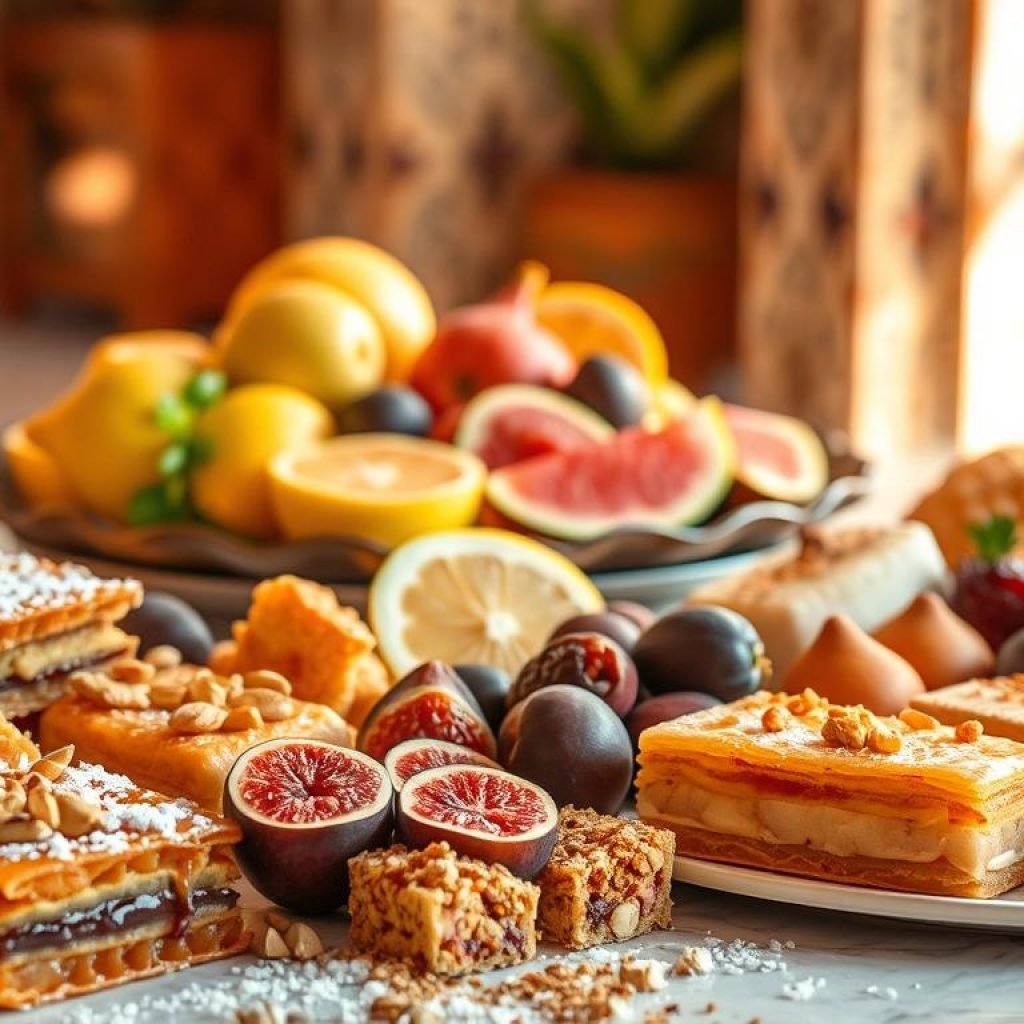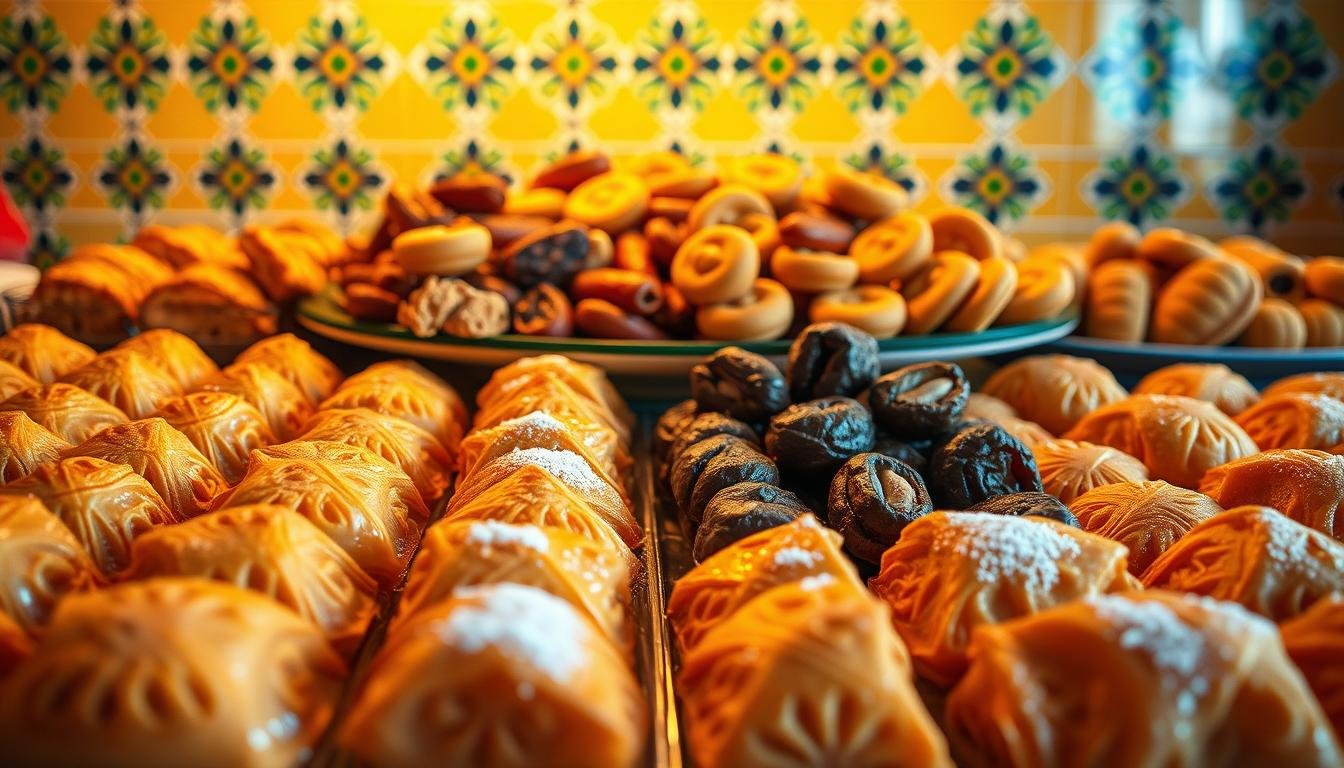What makes Moroccan desserts so unique and captivating? They reflect the rich Moroccan cuisine traditions and North African culinary heritage. Traditional Moroccan desserts are enjoyed during mid-afternoon tea time, not after meals. This is a key part of Moroccan culture.
Moroccan desserts are a big part of the country’s culinary identity. They show the diversity and richness of Moroccan cuisine traditions. You can find everything from traditional Moroccan date cookies to modern Moroccan chocolate cake. Ingredients like cinnamon, anise, and saffron give these desserts a unique flavor and aroma.
Key Takeaways
- Traditional Moroccan desserts are consumed during mid-afternoon tea time, highlighting the importance of this tradition in Moroccan culture.
- Moroccan cuisine traditions are reflected in the diverse range of desserts, from classic sweets like ghriba to modern creations like Moroccan chocolate cake.
- The North African culinary heritage is evident in the use of ingredients like cinnamon, anise, and saffron in Moroccan desserts.
- Moroccan pastries are often enjoyed during Ramadan, with a wide range of sweet treats available during this time.
- The variety of Moroccan desserts is extensive, with options like gluten-free Moroccan cookies and traditional favorites like Moroccan date cookies.
- Moroccan desserts are an integral part of the country’s cultural identity, showcasing the richness and diversity of Moroccan cuisine traditions.
Introduction to Moroccan Desserts
Moroccan cuisine is rich in history and traditions. The Origin of couscous in Morocco has greatly shaped its desserts. A mix of Arab, Berber, and French cuisines has created a unique pastry world. This world offers a wide variety of tasty desserts.
Traditional Moroccan pastries use a simple dough of white flour and almond flour. They also include spices like cinnamon, anise, and saffron. The Moroccan couscous history and Moroccan cuisine traditions have influenced the desserts. Favorites include ghuribiya, kaab el ghzal, and chebakia.
A Brief History of Moroccan Sweets
Moroccan sweets have a long history, starting in the 7th century. The Arab conquest brought new ingredients and cooking methods. Berber cuisine added nuts, honey, and dried fruits. French influence introduced butter, cream, and chocolate.
Key Ingredients in Moroccan Desserts
Key ingredients in Moroccan sweets are honey, orange blossom water, and almonds. Spices like cinnamon and saffron are also used. These ingredients create unique and delicious flavors. Favorites include almond briouat, gazelle horns, and chebakia.
Traditional Moroccan Desserts You’ll Love
Moroccan cuisine is famous for its rich flavors and aromas. Its desserts are no different. Authentic Moroccan couscous is often used in desserts, adding a special touch. Basbousa, a moist semolina cake, is flavored with almond or coconut, making it a favorite.
In Morocco, Moroccan desserts are key in celebrations. Kaab el Ghazal, or gazelle horns, are crescent-shaped cookies filled with almond paste. They’re a hit during Ramadan. The Cultural significance of couscous in Morocco is seen in desserts like couscous cakes and puddings. You can find many Couscous recipes from Morocco online to try at home.
Here are some popular traditional Moroccan desserts:
- Basbousa: a moist semolina cake
- Kaab el Ghazal: crescent-shaped cookies filled with almond paste
- Chebakia: a sweet dessert made from deep-fried dough covered in honey and sesame seeds
These desserts are not just tasty; they also show Morocco’s rich culture. Whether you try them at a Moroccan restaurant or make them at home, you’ll love the unique flavors and aromas.
Unique Moroccan Sweets to Try
Exploring Moroccan cuisine traditions means diving into the rich world of Moroccan desserts. These sweets are not just tasty but also carry deep cultural and historical meanings. They are a must-try when you visit Morocco.
At the heart of Moroccan desserts are treats like Chebakia and Briwat. They show the diversity and richness of Moroccan cuisine. Chebakia, a traditional pastry, is made with a simple dough and spices like cinnamon and saffron.
Chebakia: The Sweet Crunch
Chebakia is a big part of Ramadan iftar, showing its cultural and religious importance. It’s often saved for special occasions, making it less common than everyday desserts.
Briwat: Almond-Stuffed Pastries
Briwat is loved during Ramadan iftars and special events. It’s a key part of Moroccan celebrations. These almond-stuffed pastries reflect Morocco’s rich culinary heritage.
Trying these unique Moroccan sweets lets you enjoy delicious flavors and experience the country’s vibrant culture. Start a culinary journey through Morocco and discover its amazing desserts. They are a big part of Moroccan cuisine traditions and North African culinary heritage.
Exploring Moroccan Pastry Shops
Pastry shops are key in Moroccan cuisine traditions. They help keep the Origin of couscous in Morocco alive. These places are more than just shops; they’re where people meet to share local treats.
In Marrakech and Casablanca, you’ll find many pastry shops. They offer traditional sweets like gazelle horns and briwat. These treats are a taste of Morocco’s rich culinary world. Plus, they’re affordable, with prices starting at MAD 1-3 ($0.12-0.35).

In Marrakech and Casablanca, you can try chebakia, sellou, and briouats. These shops are known for their tasty pastries and traditional looks. Visitors can enjoy Moroccan sweets while learning about the country’s culinary history.
For those interested in Moroccan pastries, Marrakech and Casablanca have the best spots. These shops showcase Morocco’s vibrant food culture and its deep couscous history.
Seasonal Moroccan Desserts
Exploring Moroccan cuisine traditions reveals the unique seasonal desserts. These sweets are key to the country’s celebrations and gatherings. Each season introduces its own traditional sweets.
Seasonal desserts are vital in Moroccan cuisine traditions. They bring people together, like during Ramadan. Traditional cookies like chebakia are served, highlighting the rich North African culinary heritage. These desserts are not just tasty but also carry deep cultural and historical value.
Some popular seasonal Moroccan desserts include:
- Meskouta, a traditional cake made with oranges and olive oil, often served during special occasions
- Moroccan spiced oranges, a simple yet flavorful dessert made with just a few ingredients
- Moroccan Cinnamon Oranges, praised as “the perfect dessert” in cooking classes
These desserts showcase the diversity and richness of Moroccan cuisine traditions. They are more than just food; they bring people together, create lasting memories, and highlight the country’s North African culinary heritage. Exploring Moroccan desserts or trying something new, these seasonal treats will surely delight your taste buds and leave you craving more.
The Role of Desserts in Moroccan Culture
Moroccan desserts are a big deal in the country’s culture, showing up at special times. The cultural significance of couscous in Morocco is clear when it brings people together. For example, Authentic Moroccan couscous is a big hit at weddings and holidays, showing its key role in traditions.
Desserts in Moroccan culture mean more than just a sweet treat. They symbolize hospitality and generosity. Sharing traditional sweets like Couscous recipes from Morocco is a big part of social and cultural events. During Ramadan, Moroccans come together to break their fast with desserts like Chebakia and Sellou.
The importance of desserts in Moroccan culture shows in its rich culinary history. Moroccan desserts are known for their flavors, using local ingredients like organic honey and Taliouine saffron. Some favorite desserts include:
- Corne de gazelles: crescent-shaped cookies filled with almond paste and orange blossom water
- Ghriba cookies: small, round cookies made with good butter and flavored with toasted sesame and caraway seeds
- M’hancha: a traditional dessert made from filo dough and almond paste, often topped with powdered sugar, honey, or almond slices
In short, Moroccan desserts are a big part of the country’s culture and traditions. From Authentic Moroccan couscous to Couscous recipes from Morocco, they help bring people together. Whether it’s a special event or just hanging out, Moroccan desserts are a tasty way to connect and celebrate the country’s rich heritage.
How to Make Popular Moroccan Desserts at Home
Exploring Moroccan desserts reveals a rich North African culinary heritage. These desserts are a mix of unique flavors and ingredients. They are fun to make and always a hit with family and friends.
Basbousa is a favorite, a moist semolina cake that’s easy to make. You need semolina flour, sugar, eggs, and butter. Plus, orange blossom water and cinnamon for extra taste. It takes about 30 minutes to prepare, perfect for a quick dessert.
Chebakia is another favorite, a sweet fried doughnut coated in honey and sesame seeds. It’s a Ramadan treat. To make it, you need flour, yeast, and water, along with sugar and spices. Fry the doughnuts until golden, then coat in honey syrup.
Other treats include gazelle horns and seffa, a breakfast dish with vermicelli pasta and milk. These desserts are not just tasty but also carry deep cultural and culinary traditions. Exploring Moroccan desserts helps us understand the country’s rich heritage.
Healthier Moroccan Dessert Options
There are many healthier Moroccan desserts to try. Using natural sweeteners like honey and dates is a good start. These sweeteners are key in Moroccan desserts, thanks to the country’s rich history.
Some tasty options include desserts with fresh fruit like strawberries and oranges. These are not only yummy but also full of nutrients. Here’s what you get in a strawberries and yogurt dessert:

- 78 kcal per serving
- 16 g of carbohydrates
- 1 g of protein
- 1 g of fat
- 220 mg of potassium
- 2 g of fiber
- 12 g of sugar
Using Natural Sweeteners
Natural sweeteners like honey and dates are healthier than refined sugars. They add a rich flavor to desserts. For centuries, Moroccans have used them to sweeten their dishes.
Vegan Moroccan Desserts
Vegan Moroccan desserts are a great choice for those avoiding animal products. You can find many options made with fruit, almond milk, and other plant-based ingredients. These desserts capture the true flavors of Moroccan cuisine, just like traditional ones.
Pairing Moroccan Desserts with Beverages
In Moroccan cuisine, pairing desserts with drinks is key. North African culinary traditions highlight specific drinks for Moroccan sweets. Moroccan mint tea, for example, is a perfect match for traditional pastries. It offers a refreshing contrast to the desserts’ sweetness.
Choosing the right drink can really make a Moroccan dessert special. Here are some great options:
- Moroccan mint tea, which complements the sweetness of gazelle horns and other traditional pastries.
- Traditional coffee options, such as Arabic coffee, which pairs well with rich desserts like baklava.
Understanding these pairings deepens your appreciation for Moroccan desserts. Whether at home or in a restaurant, the right drink can transform the dessert experience.
Common Mistakes When Making Moroccan Desserts
Making Moroccan desserts can be tricky because of new ingredients and methods. One big mistake is not knowing the cultural significance of couscous in Morocco. This is key in desserts like Authentic Moroccan couscous recipes. It’s important to learn about the traditional Couscous recipes from Morocco and their role in Moroccan food.
Common errors include using the wrong ingredients, not using traditional cooking ways, and ignoring how the dish looks. For instance, picking the wrong couscous can mess up the dish’s texture and taste. To fix these issues, stick to traditional Couscous recipes from Morocco and choose top-notch ingredients.
Overcoming Ingredient Challenges
To beat ingredient problems, grasp the cultural significance of couscous in Morocco and its part in sweets. Here are some tips:
- Choose the best ingredients, like Authentic Moroccan couscous.
- Stick to traditional cooking ways and Couscous recipes from Morocco.
- Focus on how the dish looks and add fresh garnishes.
FAQs on Techniques
Some common questions about making Moroccan desserts are:
- What couscous type is best for desserts?
- How do I cook Authentic Moroccan couscous for the best taste?
- What are some classic Couscous recipes from Morocco I can try?
Knowing common mistakes and FAQs on techniques helps you make tasty, traditional Moroccan desserts. These show the cultural significance of couscous in Morocco.
Festivals and Events Celebrating Moroccan Desserts
Moroccan cuisine traditions are deeply rooted in the country’s North African culinary heritage. Desserts play a significant role in this heritage. Moroccan desserts are a big part of the country’s festivals and events.
They showcase the rich flavors and aromas of Moroccan cuisine traditions.
Some notable festivals and events celebrating Moroccan desserts include:
- Marrakech Pastry Festival, which honors Moroccan baked goods with classes, tastings, and competitions.
- Sefrou Cherry Festival, which highlights the cherry harvest with desserts and meals made from cherries.
- Almond Blossom Festival, which celebrates the almond harvest with desserts and cultural shows.
These festivals and events promote Moroccan cuisine traditions. They also provide a platform for people to come together. They enjoy the rich flavors of Moroccan desserts, which are essential to the North African culinary heritage.
By attending these festivals and events, visitors can experience Morocco’s vibrant culture. They can also indulge in the delicious flavors of Moroccan desserts.
Conclusion: Savoring Moroccan Delights
Exploring Moroccan desserts shows us they are more than just treats. They are vibrant expressions of Morocco’s rich culture. From the moist basbousa to the flaky chebakia, each dessert tells a story of tradition passed down through generations.
The origin of couscous in Morocco shows the lasting impact of Moroccan cuisine. Making these desserts at home lets you enjoy their flavors and learn about Moroccan couscous history. It also helps you appreciate the cultural rituals around them.
Remember, the true beauty of Moroccan sweets is in the joy and community they bring. Sharing shebakia during Hanukkah or enjoying Ramadan treats brings people together. These desserts celebrate the rich culture of Morocco.




Comment (0)